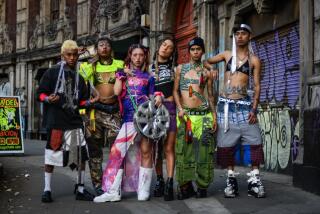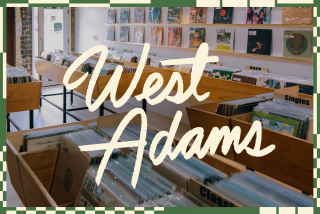Heart of the Eastside
- Share via
Some habits are just too hard to break. Eddie Ramirez knows that his family-owned pharmacy is at the corner of Cesar E. Chavez Avenue and Soto Street in Boyle Heights. But as much as he tries to keep current with new things, he still succumbs to the old ways by referring to the intersection by the name it bore when he shined shoes there in the early 1930s.
“Brooklyn and Soto,” he says, the names rolling easily off his tongue. “There’s no other place like it in L.A.”
The corner is considered by locals and some historians as the Eastside’s premier intersection. To them, it has more importance than Hollywood and Vine or Wilshire and Rodeo. They see it as a vibrant place that was at the center of the country’s biggest Jewish community west of Chicago before World War II and the nation’s largest concentration of people of Mexican descent after it.
It was there in 1938 that Jews marched to protest Kristallnacht, the vengeful day when Nazi supporters looted more than 7,000 Jewish-owned businesses and burned nearly 270 synagogues throughout Germany.
It also was there in 1994 that Chicano activists and others, mindful of Chavez’s role in the fight for decent pay and better working conditions for migrant farm workers, cheered when Brooklyn was formally renamed to honor the longtime president of the United Farm Workers union, who had died the year before.
Despite the change of the street name and the language heard on it, the intersection evokes an intimate sense of neighborhood that is often missing in Los Angeles.
“I’ve found that I can’t go anywhere in the city without finding someone who has some connection to Brooklyn and Soto,” says oral historian and filmmaker Ellie Kahn, who produced a film about the Jews of Boyle Heights, “Meet Me at Brooklyn and Soto.”
Mail carrier Marion Rodriguez, who recently retired after delivering mail in the neighborhood for nearly 30 years, notes that little has changed over the years. “You meet all kinds of people there,” she says. “They’re walking down the street, doing their shopping. I see them all every day. ‘Where’s my check?’ they’ll say.”
The history of the intersection is intertwined with the development of the bluffs east of downtown Los Angeles after the Civil War. Developer William H. Workman began subdividing the area in 1876. Married to the daughter of Andrew A. Boyle, who built the first brick home on the bluffs, Workman turned the area into the city’s first suburb. He called the area Boyle Heights in honor of his father-in-law.
To attract newcomers from the Midwest and the East, many of the streets were given names familiar to them: Chicago Street, St. Louis Street, Cincinnati Street, Michigan Avenue, Indiana Street and Brooklyn Avenue.
Among the new arrivals were Yiddish-speaking Jews from Eastern Europe. By 1920, they dominated Brooklyn and Soto. Barrels of herring and pickles were a common sight in front of stores. The Canter Brothers’ deli--related to the famed Canter’s deli on Fairfax Avenue--was a mainstay on Brooklyn. And just around the corner, the Breed Street shul was the city’s largest synagogue.
This occurred while others, mainly Mexicans and Japanese, also lived in the area.
Former residents recall the Jewish heyday in Boyle Heights with fondness.
“I recall going to [Curry’s] ice cream parlor at the corner of Brooklyn and Soto,” remembers public affairs consultant Emma Schafer. “There was the old Brooklyn Theater [now a swap meet] to watch cowboy movies. There was this sense of community. You knew the merchants and the merchants knew you.”
Politics was a commonly heard topic on the streets in those days. Radical Communists, socialists, Zionists and others argued their particular viewpoints with vigor, mostly in Yiddish. Stephen Sass, president of the Jewish Historical Society of Southern California, notes that even some Jews who shunned Yiddish to emphasize their commitment to this country were part of the lively debates.
During World War II and for several years afterward, Brooklyn and Soto was changing. Many of the sons who went off to war didn’t want to return. They wanted to get away from the old neighborhood. Still others also wanted out.
And, the immigrants who transformed the area into the heart of L.A.’s Jewish community began to die off.
By the 1950s, their place at Brooklyn and Soto was being taken over by newly arrived Mexican immigrants and other Spanish speakers who had lived in the area for years. Some Jewish merchants held on until the early 1980s, but eventually they either closed or moved on. Zellman’s, a men’s clothing store and the last business linked to the old days, closed last year.
Eventually, the talk of the street turned to the growing civil rights struggle by Mexican Americans for full participation in U.S. society. Clubs like the Community Service Organizations sprang up down the street. Then Los Angeles City Councilman Edward Roybal was a familiar figure there, stopping to eat at local taco stands.
In later years, the two politicians who succeeded Roybal, Arthur K. Snyder and Richard Alatorre, gave a nod to the corner by locating their Boyle Heights field offices there.
Although Spanish replaced Yiddish, the corner kept its vibrancy. Street musicians, offering corridos and mariachi fare, began to stroll in and out of the growing number of Mexican restaurants that cropped up near Brooklyn and Soto. The Latin American tradition of sidewalk vending began, occasionally angering old-time Jewish merchants who saw them as unfair competition.
A monument honoring “Hispanic American” recipients of the Medal of Honor was established nearby.
The corner’s place in the hearts of Latinos seemed assured when muralists, the Los Streetscapers, in the early 1980s painted the now-familiar mural there depicting residents at work and play. The mural is called “El Corrido de Boyle Heights.”
So, when Brooklyn was renamed for Chavez, the official name-change ceremony logically took place near the famed intersection.
Many residents, reliant on public transportation, use the corner as a hub to head south to the landmark Sears store at Soto and Olympic Boulevard or east to the suburban communities of Monterey Park, Alhambra and Montebello. Elvira Montanez of East Los Angeles takes the Route 68 bus to get home each day from her hairdressing job in Bell.
“From this corner,” Montanez says, “you can go anywhere on the bus. When I get to this corner to transfer, I hear the music and see the faces of the people on the street. I then know that I am home.”
Ramirez, the pharmacist who ran for governor in 1970 to publicize the concerns and political aspirations of the state’s Mexican Americans, knew all about Brooklyn and Soto, dating to his days as a shoeshine boy when he hustled for nickels and dimes in front of Irving’s restaurant at the corner.
He started a small pharmacy at 1st Street and Rowan Avenue in East Los Angeles in 1953, but was always looking for a better opportunity. When the chance came in 1976 to open a pharmacy at Brooklyn and Soto, in the spot once occupied by Irving’s, Ramirez jumped at it.
La Farmacia Ramirez--run with the help of two sons, a daughter-in-law and other relatives--has became a fixture.
“I remember the days when I used to get a tongue-on-rye sandwich for some of the store owners,” Ramirez recalls. “There were always people on the street. It’s still that way, but the language is just different. Chavez was a great man, and he deserves the recognition--but it really doesn’t matter what you call this place. I’ll never leave.”
More to Read
Sign up for Essential California
The most important California stories and recommendations in your inbox every morning.
You may occasionally receive promotional content from the Los Angeles Times.










